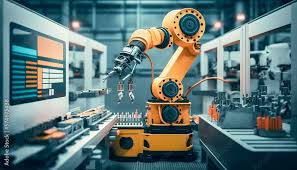Introduction
Industry 4.0 represents the fourth industrial revolution, characterized by the integration of cyber-physical systems, the Internet of Things (IoT), and advanced data analytics into manufacturing and industrial processes. This revolution is transforming industries by enabling smarter, more efficient, and highly interconnected operations. This article explores the evolution of Industry 4.0, its key technologies, benefits, challenges, and future prospects.
Evolution of Industry 4.0
The journey to Industry 4.0 can be traced through previous industrial revolutions:
- First Industrial Revolution (18th Century): The advent of mechanization powered by steam engines transformed agriculture and manufacturing, leading to the development of factories.
- Second Industrial Revolution (Late 19th and Early 20th Century): The introduction of electricity and mass production techniques, such as the assembly line, revolutionized manufacturing processes, increasing efficiency and output.
- Third Industrial Revolution (Late 20th Century): The rise of electronics, information technology, and automation marked the third revolution. Computer systems and robotics began to automate manufacturing processes, further enhancing productivity.
- Industry 4.0 (21st Century): The current industrial revolution is driven by digitalization, cyber-physical systems, and the IoT. Industry 4.0 integrates advanced technologies to create smart factories and interconnected supply chains.
Key Technologies of Industry 4.0
- Internet of Things (IoT): IoT connects devices and systems, enabling real-time data exchange and monitoring. In industrial settings, IoT sensors track equipment performance, monitor production processes, and optimize resource usage.
- Cyber-Physical Systems: These systems combine physical processes with computational elements, allowing for real-time interaction and control. Examples include smart grids, autonomous vehicles, and advanced manufacturing systems.
- Big Data and Analytics: The ability to collect and analyze large volumes of data is central to Industry 4.0. Advanced analytics provide insights into operations, predictive maintenance, and process optimization.
- Artificial Intelligence (AI) and Machine Learning: AI and machine learning algorithms enable intelligent decision-making and automation. These technologies enhance predictive maintenance, quality control, and supply chain optimization.
- Robotics and Automation: Advanced robotics and automated systems perform complex tasks with high precision and speed. Collaborative robots (cobots) work alongside human workers, enhancing productivity and safety.
- Cloud Computing: Cloud platforms provide scalable storage and computing power, facilitating data sharing and collaboration across the supply chain. Cloud computing supports the integration and analysis of data from diverse sources.
- Additive Manufacturing (3D Printing): Additive manufacturing allows for the production of complex and customized products with minimal waste. This technology is revolutionizing prototyping, production, and supply chain logistics.
- Augmented Reality (AR) and Virtual Reality (VR): AR and VR technologies enhance training, maintenance, and design processes. These immersive technologies enable workers to visualize complex tasks and simulate different scenarios.
Benefits of Industry 4.0
- Increased Efficiency and Productivity: Industry 4.0 technologies optimize production processes, reduce downtime, and enhance resource utilization. This leads to higher efficiency and productivity in manufacturing operations.
- Improved Quality and Consistency: Advanced analytics and real-time monitoring ensure consistent product quality by identifying defects and variances early in the production process.
- Enhanced Flexibility and Customization: Industry 4.0 enables greater flexibility in production, allowing for the customization of products to meet specific customer demands. This is particularly beneficial in industries such as automotive and electronics.
- Predictive Maintenance: IoT sensors and AI algorithms predict equipment failures before they occur, reducing unplanned downtime and maintenance costs. This proactive approach extends the lifespan of machinery.
- Supply Chain Optimization: Real-time data exchange and analytics improve supply chain visibility and coordination. Companies can optimize inventory levels, reduce lead times, and respond more quickly to market changes.
- Energy and Resource Efficiency: Industry 4.0 technologies enable more efficient use of energy and raw materials. This not only reduces costs but also minimizes the environmental impact of industrial operations.
- Workforce Empowerment: Automation and digital tools enhance worker productivity and safety. AR and VR technologies provide immersive training experiences, improving skills and reducing errors.
Challenges of Implementing Industry 4.0
- High Implementation Costs: The adoption of Industry 4.0 technologies requires significant investment in infrastructure, equipment, and training. This can be a barrier, especially for SMEs.
- Data Security and Privacy: The increased connectivity and data exchange in Industry 4.0 pose cybersecurity risks. Protecting sensitive data and ensuring secure communication is critical.
- Integration with Legacy Systems: Integrating new technologies with existing legacy systems can be complex. Ensuring compatibility and seamless operation requires careful planning and technical expertise.
- Skill Gaps: The shift to Industry 4.0 demands a workforce with advanced technical skills. Addressing the skill gap through education, training, and reskilling programs is essential.
- Regulatory and Compliance Issues: Navigating regulatory requirements and ensuring compliance with standards can be challenging. Companies must stay abreast of changing regulations and adapt their operations accordingly.
- Change Management: Implementing Industry 4.0 involves significant organizational change. Managing resistance and fostering a culture of innovation and continuous improvement is crucial for success.
Case Studies
- Bosch: Bosch has implemented Industry 4.0 technologies across its manufacturing plants, leveraging IoT, AI, and big data analytics to optimize production processes. The company’s smart factories achieve higher efficiency, flexibility, and quality.
- Siemens: Siemens’ Amberg Electronics Plant is a prime example of Industry 4.0 in action. The plant uses a combination of IoT, automation, and data analytics to produce a wide range of products with high precision and minimal waste.
- Harley-Davidson: Harley-Davidson’s York, Pennsylvania plant has embraced Industry 4.0 technologies to enhance production efficiency and customization. The company uses advanced manufacturing systems to produce customized motorcycles with shorter lead times.
Future Prospects
The future of Industry 4.0 is marked by continuous technological advancements and the growing integration of digital and physical systems. Key trends and developments include:
- Edge Computing: Edge computing will enable real-time data processing at the source, reducing latency and improving the responsiveness of industrial systems.
- 5G Connectivity: The rollout of 5G networks will enhance the speed and reliability of data exchange, supporting the widespread adoption of IoT and other Industry 4.0 technologies.
- AI and Machine Learning Advancements: Ongoing advancements in AI and machine learning will drive further innovation in predictive maintenance, quality control, and process optimization.
- Sustainability Focus: Industry 4.0 will increasingly prioritize sustainability, with technologies designed to minimize environmental impact and optimize resource use.
- Human-Machine Collaboration: The future will see greater collaboration between humans and machines, with cobots and advanced interfaces enabling seamless interaction and cooperation.
- Digital Twins: The use of digital twins—virtual replicas of physical systems—will become more prevalent, allowing companies to simulate and optimize operations in a virtual environment.
Conclusion
Industry 4.0 is transforming modern industry by integrating advanced technologies and creating smarter, more efficient operations. While the implementation of Industry 4.0 poses challenges, the benefits in terms of increased productivity, improved quality, and enhanced flexibility are substantial. As technology continues to evolve, the future of Industry 4.0 promises even greater innovation and efficiency, driving the industrial sector towards a more interconnected, intelligent, and sustainable future.


